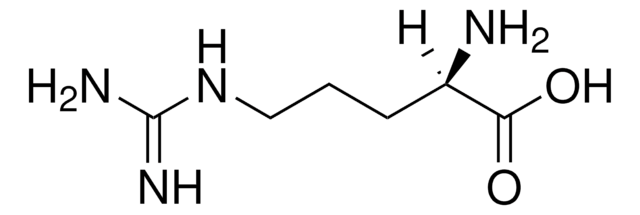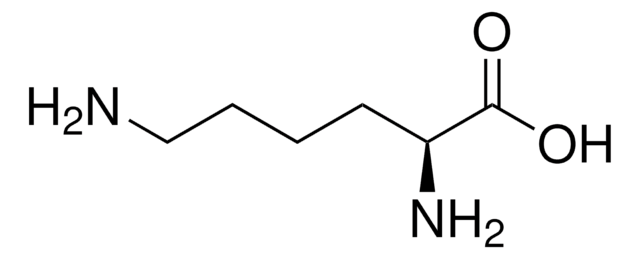全部照片(5)
About This Item
經驗公式(希爾表示法):
C6H14N4O2 · HCl
CAS號碼:
分子量::
210.66
EC號碼:
MDL號碼:
分類程式碼代碼:
12352209
PubChem物質ID:
NACRES:
NA.26
推薦產品
product name
DL-精氨酸 盐酸盐, ≥98% (TLC)
化驗
≥98% (TLC)
形狀
powder
顏色
white to off-white
mp
128-130 °C
溶解度
H2O: soluble
SMILES 字串
Cl.NC(CCCNC(N)=N)C(O)=O
InChI
1S/C6H14N4O2.ClH/c7-4(5(11)12)2-1-3-10-6(8)9;/h4H,1-3,7H2,(H,11,12)(H4,8,9,10);1H
InChI 密鑰
KWTQSFXGGICVPE-UHFFFAOYSA-N
相關類別
應用
DL-精氨酸盐酸盐(DL-Arg)是天然蛋白氨基酸L-精氨酸和非蛋白蛋白D-精氨酸的外消旋混合物。DL-Arg用于氨基酸络合动力学和晶体结构形成的物理化学分析。
基底
一氧化氮合酶的底物;通过一氧化氮依赖性机制诱导胰岛素释放。
儲存類別代碼
11 - Combustible Solids
水污染物質分類(WGK)
WGK 3
閃點(°F)
Not applicable
閃點(°C)
Not applicable
個人防護裝備
Eyeshields, Gloves, type N95 (US)
分析證明 (COA)
輸入產品批次/批號來搜索 分析證明 (COA)。在產品’s標籤上找到批次和批號,寫有 ‘Lot’或‘Batch’.。
客戶也查看了
N T Saraswathi et al.
Acta crystallographica. Section B, Structural science, 59(Pt 5), 641-646 (2003-10-31)
The complexes of L-arginine and DL-lysine with pimelic acid are made up of singly positively charged zwitterionic amino acid cations and doubly negatively charged pimelate ions in a 2:1 ratio. In both structures, the amino acid molecules form twofold symmetric
Siddhartha Roy et al.
Acta crystallographica. Section B, Structural science, 61(Pt 1), 89-95 (2005-01-22)
The adipic acid complexes of DL-arginine and L-arginine are made up of zwitterionic, singularly positively charged arginium ions and doubly negatively charged adipate ions, with a 2:1 stoichiometry. One of the two crystallographically independent arginium ions in the L-arginine complex
Moyu Taniguchi et al.
Journal of bioscience and bioengineering, 124(4), 414-418 (2017-06-02)
Although naturally abundant amino acids are represented mainly by l-enantiomers, fermented foods are known to contain various d-amino acids. Enantiospecific profiles of food products can vary due to fermentation by bacteria, and such alterations may contribute to changes in food
Yosuke Nakano et al.
Journal of bioscience and bioengineering, 123(1), 134-138 (2016-08-21)
d-Amino acids have recently attracted much attention in various research fields including medical, clinical and food industry due to their important biological functions that differ from l-amino acid. Most chiral amino acid separation techniques require complicated derivatization procedures in order
Moyu Taniguchi et al.
Journal of bioscience and bioengineering, 130(1), 63-70 (2020-04-09)
Japanese sake production involves three processes: rice koji fermentation, seed mash fermentation, and main mash fermentation. Traditional seed mash (kimoto) production utilizes natural lactic acid produced by lactic acid bacteria for pure cultures of only sake yeast, preventing the growth
Chromatograms
application for HPLC我們的科學家團隊在所有研究領域都有豐富的經驗,包括生命科學、材料科學、化學合成、色譜、分析等.
聯絡技術服務






